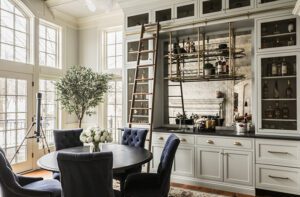Interview: George Champion
January 20, 2014
From his little shop on Woodbury’s quaint Antiques Row, one dealer has quietly built up a thriving trade in an unexpected quarter: modern design, often with an Italian accent.
Text by Kyle Hoepner Photography by Jane Shauck
Kyle Hoepner: How long have you been dealing in twentieth-century modern furniture and design?
George Champion: In one form or another, I have been dealing this material for about twenty-five years.
KH: I’ve read that your interest in the field grew out of your father’s manufacturing work. Can you walk us through how that happened?
GC: My father was a person who appreciated, loved, and expected the best from the people and the things around him. He was always showing me the difference in a quality product versus an inferior model, why a certain machine was better designed or better constructed than another. He always pointed to cast iron versus stamped steel, leather versus plastic, and had little or no tolerance for shoddy design or build quality.
KH: Did you expect to end up doing what you do now?
GC: I don’t think I did. I think it became a natural extension of my own collecting. My own quest for knowledge and refinement just seemed to need an outlet beyond what I was doing for myself.
KH: Have you always collected the same sorts of things?
GC: My collecting interest started with Shaker furniture. It was the first furniture I ever loved, and I sought it out with fervor. This beautifully made, unadorned, practical furniture is, in my eyes, the first great modern furniture. It became my bridge from antique to modern—in much the same way, I later learned, it served for many of the Scandinavian and other modern designers, even the great George Nakashima.
KH: Are you a Woodbury native? If not, what about Woodbury drew you to settle and open your shop there?
GC: I’ve been here quite a while, but I’m not a native. I do live in Woodbury in addition to having my business here. Woodbury is a great town, retaining its rural charm, but offering all the services you would find in a larger town or city. My shop on Main Street is easily accessible from I-84 and not a long drive from New York or any Connecticut city.
KH: Midcentury modern design has been having a notable vogue in recent years. Do you see that continuing?
GC: I do see this period of design as finally getting its due. It is important material, historically and aesthetically. This kind of design, born out of new ideas, new materials, and intelligent new designers educated in new curriculums of the time (Cranbrook, the Bauhaus in Germany and Chicago, and others), formed a whole new expression that I think will stay with us the way great designs of the past (Chippendale, Queen Anne, etcetera) have.
KH: What changes have you seen in the market over time? What changes in the kinds of pieces being collected?
GC: It seems to have started with the very pure pieces, with the Bauhaus, and moved on to the early modern pieces designed by Charles and Ray Eames, George Nelson, Florence Knoll, Harry Bertoia, and so forth. As the Internet became more prevalent, interest seemed to increase for more international designs and eventually more obscure designers, American and otherwise.
KH: Looking around your shop, Italian design seems to account for a pretty large share of your acquisitions.
GC: After exploring this material as much as I have, I have found that the Italian designs, primarily midcentury and continuing forward, are usually the ones that get my heart fluttering. It’s hard to explain; perhaps it’s a soulfulness, a disregard for market demands…or like the feeling you get when you listen to Pavarotti, see a Ferrari, or hear a Ducati motorcycle go by. For whatever reason, these are the things I like to surround myself with, and I continue to enjoy sharing their beauty with others.
KH: You have recently restored the Victorian house next door to your shop for use as additional gallery space. How has displaying in that setting affected your business?
GC: Using the house as a showroom has changed our business dramatically. Let’s face it: most people in Connecticut have a fairly traditional home, and the Victorian has allowed us to display our modern pieces in a traditional setting. The pieces show well, and it gives people the confidence that this kind of design can look good in a space that may be closer in feel to their own homes.
My shop is not one full of objects that happen to fit particular criteria based on a specialty of style or movement. The objects in the shop, regardless of their significance, are there because they had a special resonance for me when I discovered them. Whether it be an ashtray from a hotel in Florence, a plywood tray from Denmark, or vintage McIntosh stereo equipment, they all have meaning for me and become the mix that visitors to the shop seem to enjoy.
KH: Do you sell online?
GC: We do have a web presence and often sell that way. It is business, but not my favored way of doing business. Most of my customers become friends of the shop; they stop by to look and say hello, and we develop relationships that are beneficial to both of us. Online customers are usually one-time buyers, surfing for what they want; they seldom develop into anything more.
KH: What is it about midcentury modern design you particularly love? What qualities would you most urge potential fans or collectors to appreciate?
GC: In addition to the outward beauty and utility of an object, I am interested in the innovation it represents, in its being the first or the best at expressing something—whether it be a great artist such as Noguchi giving us beautiful furniture and lighting forms; or industrious pioneers like Charles and Ray Eames using fiberglass, plywood, wire, and aluminum in new ways; or later innovators like Marcel Wanders making a sit-able chair out of macramé rope and resin. These are things that interest me, and that I think collectors in general should be paying attention to.
KH: Where do you see yourself going from here?
GC: I believe I will continue to deal in the older material that interests me, from the U.S., Italy, France, Japan, and other countries, but hope to expand on those offerings with newer designs that excite me. I travel to the Milan fair [the Salone Internazionale del Mobili, held every spring —ed.] most years and keep my eyes and ears open for exciting new things that are happening anywhere. It would be a joy for me to bring these things in and have them appreciated here in little old Woodbury. •
George Champion Company, Woodbury, (203) 263-8442, georgechampioncompany.com
Share
![NEH-Logo_Black[1] NEH-Logo_Black[1]](https://www.nehomemag.com/wp-content/uploads/2022/08/NEH-Logo_Black1-300x162.jpg)














You must be logged in to post a comment.